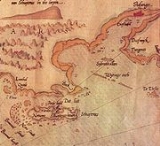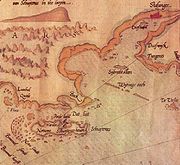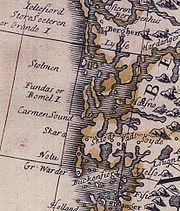
Notow
Encyclopedia
Notow was a trading port located at the northeast of Karmøy
, or more specifically located at the king's port area in Avaldsnes
. According to the 16th century book Die Nordische Saw, the first Hanseatic
Kontor
established in Norway
(before Bryggen
in Bergen
) was based in Notow. However, despite a Hanseatic presence at Notow, the existence of a Hanseatic "Kontor" or permanent trading post there is not supported by contemporary sources, and not accepted among modern historians.
At Bukkøy there currently exist places named Nora Nottå, Søra Nottå and Nåttåhavn which probably derives from the earlier Notow.

 An early mention of the Hanseatics at Avaldsnes is in a letter by Norwegian king Haakon VI
An early mention of the Hanseatics at Avaldsnes is in a letter by Norwegian king Haakon VI
from around 1370. Here he writes about the Hanseatics which "at peacetime raided and burned the king's farms at Avaldsnes and others by the Karmsund, his forests near Selbjørn, the houses for poor travelers between Karmsund and Bergen, and also farms and houses at the Karmsund that belonged to the kings subjects". The Hanseatics has here apparently destroyed everything the king owns near the coast from Bergen to perhaps the Swedish border. The reasons for this attack by the Hansa was that the king had tried to limit the Hanseatics trade in Norway.
Notow is also later specifically mentioned in numerous Hanseatic and Norwegian documents between 1425 and 1523.
In a testament from 1425 it is written: "Item to Notow geve ik 2 tunnen teres to dem buwe" ("Likewise I give two barrels of tar for construction-purposes in Notow"). This suggests that the Hansa wasn't only residing in the port, but also being involved in construction of new projects there.
In the winter of 1470/71 the Lübeck fleet for Bergen is known to have stayed at Notow.
In a letter from Lübeck, probably in or around 1486, it is described how in the years 1450-55 Hanseatic ships and people, in Bergen and other places, had been exposed to great violence and robberies. Among the places mentioned was Notouw where "Oloff Nyelsson" and Bishop "Torlaus de Engelschen" had attacked Hanseatic ships which held great values.Diplomatarium Norvegicum XVI p.317 Date: 1486? Place: Lübeck.
"[...] Anno liiij jn den pinxten nemen de Engelschen by den |
Schagen deme kopmanne viij schepe gheladen de werde van xvj |
dusent marck, Dar na vth Engelland quemen to Notouw ij laden |
schepe myt wande de werde van x dusent marck Lub. Dar na |
makede de kopman vth volk vnde schepe, vnde dachte synen |
schaden na tokamende, do entf#orde Here Oloff Nyelsson vnd |
Bisschop Torlauus de Engelschen vnde nemen dar vor vjc Rin- |
sche gulden ij scharlaken vnde jslick dener eyn halff laken |
Do suluest te Scheringessunde vnde to Maestrande nam |
Here Oloff vnde Nyelsz Petersson vnde ere zelschop vele, laden |
schepe sunderges Clawes Ghysen Tho Seel#o xi schepe vnde ij |
van Rostock bauen den vreden des Heren konynges vnde vor- |
segelinge [des H1 der iiij Ryddere vnde der Stede pryuilegie |
Schade x dusent marck [...]"
Written sources, such as these, suggests that Notow in the 15th century was controlled by the Hansa of Bergen and Lübeck
.
In 1584 an unknown German in Bergen
wrote a curious text called Die Nordische Saw (The Norwegian sowSow as in female pig). In the text, Nothaw is said to have been for a long time one of the four original Kontor of the Hansa, along with London
, Novgorod and Brugge
. The text thus implies that Notow was the first place where the Hansa was established in Norway, but from here they soon had to relocate to Bergen due to consistent trouble with "pirates". (It has been speculated that these "pirates" in reality were representatives for the Norwegian king.). This claim is, however, not supported by any other sources, and not generally accepted by historians.
Dutch
maritime maps from the last part of the 16th and the 17th century also locate Notow at Avaldsnes
.
, glass
, animal bones and such. These objects are mostly just simple waste from the settlement of the port. Almost all of these items have been dated to the period between the 13th, and the 16th century.
Medieval shipwrecks have also been found, with one being radiocarbon-dated to between 1230 and 1280. This shipwreck is now about 17 meters long, but the ship was probably around 22 meters long when it was in use. As the ship was made of timber from oak
, it was most likely built in southern Scandinavia.
More odd items found is a musical instrument known as a "Pilgrim's horn", made in the German town of Aachen
in the 15th century where such horns are known to have been used at coronation ceremonies or religious holidays, and a mortar made of Rhine basalt. This is evidences of contact across the North Sea.
There has however not been found any certain traces of Notow on land, but it should be noted though that Bukkøy presently is covered in a rather thick pine forest, making searches more difficult.
Karmøy
Karmøy is a municipality in Rogaland county, Norway. It is located southwest of the city of Haugesund in the traditional district of Haugaland....
, or more specifically located at the king's port area in Avaldsnes
Avaldsnes
Avaldsnes was an ancient centre of power on the west coast of Norway and is the site of one of Norway’s more important areas of cultural history...
. According to the 16th century book Die Nordische Saw, the first Hanseatic
Hanseatic League
The Hanseatic League was an economic alliance of trading cities and their merchant guilds that dominated trade along the coast of Northern Europe...
Kontor
Kontor
A kontor was a foreign trading post of the Hanseatic League. The word kontor means office in Norwegian and other Scandinavian languages....
established in Norway
Norway
Norway , officially the Kingdom of Norway, is a Nordic unitary constitutional monarchy whose territory comprises the western portion of the Scandinavian Peninsula, Jan Mayen, and the Arctic archipelago of Svalbard and Bouvet Island. Norway has a total area of and a population of about 4.9 million...
(before Bryggen
Bryggen
Bryggen , also known as Tyskebryggen is a series of Hanseatic commercial buildings lining the eastern side of the fjord coming into Bergen, Norway. Bryggen has since 1979 been on the UNESCO list for World Cultural Heritage sites. The name has the same origin as the Flemish city of Brugge.The city...
in Bergen
Bergen
Bergen is the second largest city in Norway with a population of as of , . Bergen is the administrative centre of Hordaland county. Greater Bergen or Bergen Metropolitan Area as defined by Statistics Norway, has a population of as of , ....
) was based in Notow. However, despite a Hanseatic presence at Notow, the existence of a Hanseatic "Kontor" or permanent trading post there is not supported by contemporary sources, and not accepted among modern historians.
At Bukkøy there currently exist places named Nora Nottå, Søra Nottå and Nåttåhavn which probably derives from the earlier Notow.
Contemporary writing


Haakon VI of Norway
Haakon VI of Norway was King of Norway from 1343 until his death and King of Sweden from 1362 until 1364, when he was deposed by Albert of Mecklenburg in Sweden.-Background:...
from around 1370. Here he writes about the Hanseatics which "at peacetime raided and burned the king's farms at Avaldsnes and others by the Karmsund, his forests near Selbjørn, the houses for poor travelers between Karmsund and Bergen, and also farms and houses at the Karmsund that belonged to the kings subjects". The Hanseatics has here apparently destroyed everything the king owns near the coast from Bergen to perhaps the Swedish border. The reasons for this attack by the Hansa was that the king had tried to limit the Hanseatics trade in Norway.
Notow is also later specifically mentioned in numerous Hanseatic and Norwegian documents between 1425 and 1523.
In a testament from 1425 it is written: "Item to Notow geve ik 2 tunnen teres to dem buwe" ("Likewise I give two barrels of tar for construction-purposes in Notow"). This suggests that the Hansa wasn't only residing in the port, but also being involved in construction of new projects there.
In the winter of 1470/71 the Lübeck fleet for Bergen is known to have stayed at Notow.
In a letter from Lübeck, probably in or around 1486, it is described how in the years 1450-55 Hanseatic ships and people, in Bergen and other places, had been exposed to great violence and robberies. Among the places mentioned was Notouw where "Oloff Nyelsson" and Bishop "Torlaus de Engelschen" had attacked Hanseatic ships which held great values.Diplomatarium Norvegicum XVI p.317 Date: 1486? Place: Lübeck.
"[...] Anno liiij jn den pinxten nemen de Engelschen by den |
Schagen deme kopmanne viij schepe gheladen de werde van xvj |
dusent marck, Dar na vth Engelland quemen to Notouw ij laden |
schepe myt wande de werde van x dusent marck Lub. Dar na |
makede de kopman vth volk vnde schepe, vnde dachte synen |
schaden na tokamende, do entf#orde Here Oloff Nyelsson vnd |
Bisschop Torlauus de Engelschen vnde nemen dar vor vjc Rin- |
sche gulden ij scharlaken vnde jslick dener eyn halff laken |
Do suluest te Scheringessunde vnde to Maestrande nam |
Here Oloff vnde Nyelsz Petersson vnde ere zelschop vele, laden |
schepe sunderges Clawes Ghysen Tho Seel#o xi schepe vnde ij |
van Rostock bauen den vreden des Heren konynges vnde vor- |
segelinge [des H1 der iiij Ryddere vnde der Stede pryuilegie |
Schade x dusent marck [...]"
Written sources, such as these, suggests that Notow in the 15th century was controlled by the Hansa of Bergen and Lübeck
Lübeck
The Hanseatic City of Lübeck is the second-largest city in Schleswig-Holstein, in northern Germany, and one of the major ports of Germany. It was for several centuries the "capital" of the Hanseatic League and, because of its Brick Gothic architectural heritage, is listed by UNESCO as a World...
.
In 1584 an unknown German in Bergen
Bergen
Bergen is the second largest city in Norway with a population of as of , . Bergen is the administrative centre of Hordaland county. Greater Bergen or Bergen Metropolitan Area as defined by Statistics Norway, has a population of as of , ....
wrote a curious text called Die Nordische Saw (The Norwegian sowSow as in female pig). In the text, Nothaw is said to have been for a long time one of the four original Kontor of the Hansa, along with London
London
London is the capital city of :England and the :United Kingdom, the largest metropolitan area in the United Kingdom, and the largest urban zone in the European Union by most measures. Located on the River Thames, London has been a major settlement for two millennia, its history going back to its...
, Novgorod and Brugge
Brügge
Brügge is a municipality in the district of Rendsburg-Eckernförde, in Schleswig-Holstein, Germany.Its small church and market square are noted for their beauty....
. The text thus implies that Notow was the first place where the Hansa was established in Norway, but from here they soon had to relocate to Bergen due to consistent trouble with "pirates". (It has been speculated that these "pirates" in reality were representatives for the Norwegian king.). This claim is, however, not supported by any other sources, and not generally accepted by historians.
Dutch
Dutch people
The Dutch people are an ethnic group native to the Netherlands. They share a common culture and speak the Dutch language. Dutch people and their descendants are found in migrant communities worldwide, notably in Suriname, Chile, Brazil, Canada, Australia, South Africa, New Zealand, and the United...
maritime maps from the last part of the 16th and the 17th century also locate Notow at Avaldsnes
Avaldsnes
Avaldsnes was an ancient centre of power on the west coast of Norway and is the site of one of Norway’s more important areas of cultural history...
.
Archaeological excavations
At the bottom of the sea of the coast near Avaldsnes church (between Gloppenes and Fårøy) there has been found numerous ceramics of German and Dutch origins, in addition to leatherLeather
Leather is a durable and flexible material created via the tanning of putrescible animal rawhide and skin, primarily cattlehide. It can be produced through different manufacturing processes, ranging from cottage industry to heavy industry.-Forms:...
, glass
Glass
Glass is an amorphous solid material. Glasses are typically brittle and optically transparent.The most familiar type of glass, used for centuries in windows and drinking vessels, is soda-lime glass, composed of about 75% silica plus Na2O, CaO, and several minor additives...
, animal bones and such. These objects are mostly just simple waste from the settlement of the port. Almost all of these items have been dated to the period between the 13th, and the 16th century.
Medieval shipwrecks have also been found, with one being radiocarbon-dated to between 1230 and 1280. This shipwreck is now about 17 meters long, but the ship was probably around 22 meters long when it was in use. As the ship was made of timber from oak
Oak
An oak is a tree or shrub in the genus Quercus , of which about 600 species exist. "Oak" may also appear in the names of species in related genera, notably Lithocarpus...
, it was most likely built in southern Scandinavia.
More odd items found is a musical instrument known as a "Pilgrim's horn", made in the German town of Aachen
Aachen
Aachen has historically been a spa town in North Rhine-Westphalia, Germany. Aachen was a favoured residence of Charlemagne, and the place of coronation of the Kings of Germany. Geographically, Aachen is the westernmost town of Germany, located along its borders with Belgium and the Netherlands, ...
in the 15th century where such horns are known to have been used at coronation ceremonies or religious holidays, and a mortar made of Rhine basalt. This is evidences of contact across the North Sea.
There has however not been found any certain traces of Notow on land, but it should be noted though that Bukkøy presently is covered in a rather thick pine forest, making searches more difficult.

